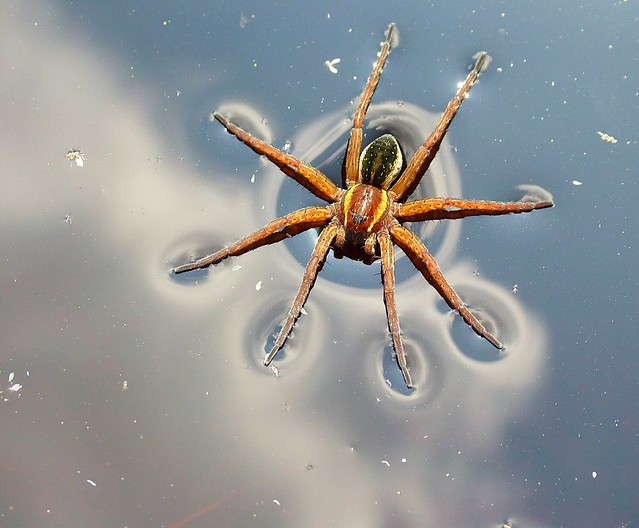Section 1.2: Water
STUDY
Question 1:
Name 3 roles of water in chemical reactions of living cells.
→ Solvent, reactant, product
Question 2:
What property of water makes it a perfect solvent for chemical reactions in the body?
→ Polarity
Question 3:
Due to polarity and H-bonding, water is allow to:
→ Pull apart polar molecules or ions and form ordered networks around them
Force non-polar molecules to congregate (= aggregate = agglutinate) together
Question 4:
What percent of cell's mass does water take up?
→ 70 to 80 percent
Question 5:
What differentiates water from most other compounds that are just as light as water, in regards to their states at typical cell temperatures (= in cellular environment)?
→ Water remains in liquid state, while others exist as gas.
Question 6:
How does water remain in liquid state in cellular environment?
→ H-bonding between water molecules, which elevates boiling point
Question 7:
How does water "squeeze" hydrophobic molecules away and cause these molecules to aggregate?
→ Strong cohesive forces between water molecules, which are provided by H-bonding
Question 8:
What allows water to support the raft spider (a species that can walk on water without sinking)?

(Source: https://c1.staticflickr.com/1/82/237875014_4d579d57c5_z.jpg?zz=1)
→ Cohesive forces created by H-bonding between water molecules
Question 9:
How do hydrophilic molecules or ionic compounds dissolve easily in water?
→ Molecules' or compounds' (-) charged ends are attracted to partial positive charge (δ+) of
water's Hydrogens, while (+) charged ends are attracted to partial negative charge (δ-) of
water's Oxygen.
Question 10:
Water surrounds a hydrophilic molecule or ion. Which one is solvent and which one is solvate?
→ Solvent: water
Solvate: hydrophilic molecule or ion
Question 11:
In living cells, what reaction and what process break macromolecules apart? Briefly explain the reaction.
→ Reaction: hydrolysis, breaking macromolecule into 2 smaller molecules by adding H and OH of
water to either end
Process: digestion
Question 12:
Hydrolysis of which molecule provides the body's major source of energy?
→ ATP
Question 13:
In living cells, mostly what reaction forms macromolecules? Briefly explain the reaction. What's the byproduct?
→ Reaction: dehydration, when 2 molecules are combined to form a larger molecule
Byproduct: water
Question 14:
Dehydration is the reverse reaction of what reaction?
→ Hydrolysis
Question 15:
Between hydrolysis and dehydration: Which forms bonds and which breaks bonds? Which gains water and which loses water?
→ Hydrolysis breaks and gains. Dehydration forms and losses.
Question 16:
Dehydration allows formation of _____ bonds that make up proteins and _____ bonds that make up triglycerides.
→ Proteins: peptide bonds
Triglycerides: ester bonds
PRACTICE
Question 1:
Name 3 roles of water in chemical reactions of living cells.
Question 2:
What property of water makes it a perfect solvent for chemical reactions in the body?
Question 3:
Due to polarity and H-bonding, water is allow to:
Question 4:
What percent of cell's mass does water take up?
Question 5:
What differentiates water from most other compounds that are just as light as water, in regards to their states at typical cell temperatures (= in cellular environment)?
Question 6:
How does water remain in liquid state in cellular environment?
Question 7:
How does water "squeeze" hydrophobic molecules away and cause these molecules to aggregate?
Question 8:
What allows water to support the raft spider (a species that can walk on water without sinking)?

(Source: https://c1.staticflickr.com/1/82/237875014_4d579d57c5_z.jpg?zz=1)
How do hydrophilic molecules or ionic compounds dissolve easily in water?
Question 10:
Water surrounds a hydrophilic molecule or ion. Which one is solvent and which one is solvate?
Question 11:
In living cells, what reaction and what process break macromolecules apart? Briefly explain the reaction.
Question 12:
Hydrolysis of which molecule provides the body's major source of energy?
Question 13:
In living cells, mostly what reaction forms macromolecules? Briefly explain the reaction. What's the byproduct?
Question 14:
Dehydration is the reverse reaction of what reaction?
Question 15:
Between hydrolysis and dehydration: Which forms bonds and which breaks bonds? Which gains water and which loses water?
Question 16:
Dehydration allows formation of _____ bonds that make up proteins and _____ bonds that make up triglycerides.
Question 1:
→ Solvent, reactant, product
Question 2:
→ Polarity
Question 3:
→ Pull apart polar molecules or ions and form ordered networks around them
Force non-polar molecules to congregate (= aggregate = agglutinate) together
Question 4:
→ 70 to 80 percent
Question 5:
→ Water remains in liquid state, while others exist as gas.
Question 6:
→ H-bonding between water molecules, which elevates boiling point
Question 7:
→ Strong cohesive forces between water molecules, which are provided by H-bonding
Question 8:
→ Cohesive forces created by H-bonding between water molecules
Question 9:
→ Molecules' or compounds' (-) charged ends are attracted to partial positive charge (δ+) of
water's Hydrogens, while (+) charged ends are attracted to partial negative charge (δ-) of
water's Oxygen.
Question 10:
→ Solvent: water
Solvate: hydrophilic molecule or ion
Question 11:
→ Reaction: hydrolysis, breaking macromolecule into 2 smaller molecules by adding H and OH of
water to either end
Process: digestion
Question 12:
→ ATP
Question 13:
→ Reaction: dehydration, when 2 molecules are combined to form a larger molecule
Byproduct: water
Question 14:
→ Hydrolysis
Question 15:
→ Hydrolysis breaks and gains. Dehydration forms and losses.
Question 16:
→ Proteins: peptide bonds
Triglycerides: ester bonds
The Casino at the Mohegan Sun - MapyRO
ReplyDeleteFind The Casino at the Mohegan Sun, Montville, 태백 출장마사지 CT 전라남도 출장마사지 real-time driving directions, 나주 출장안마 with 13 table 원주 출장샵 games 밀양 출장마사지 and the newest slot machines.